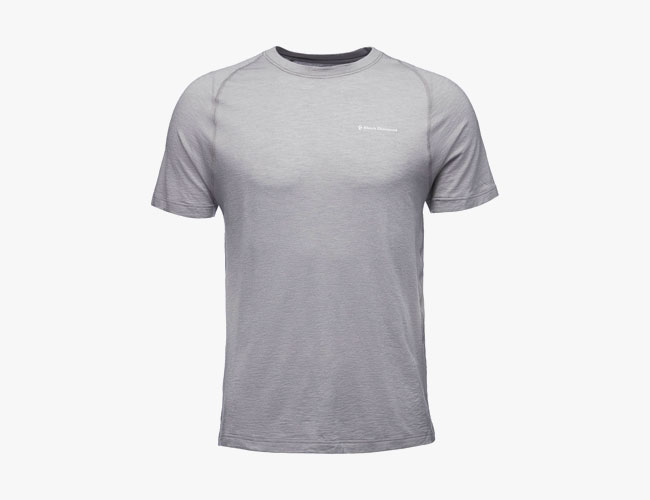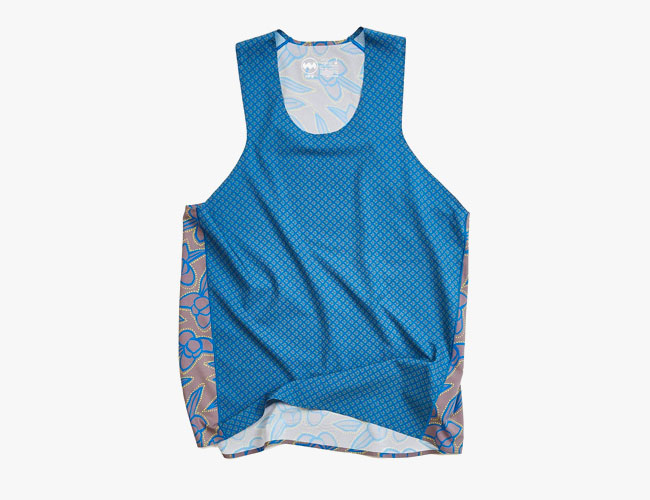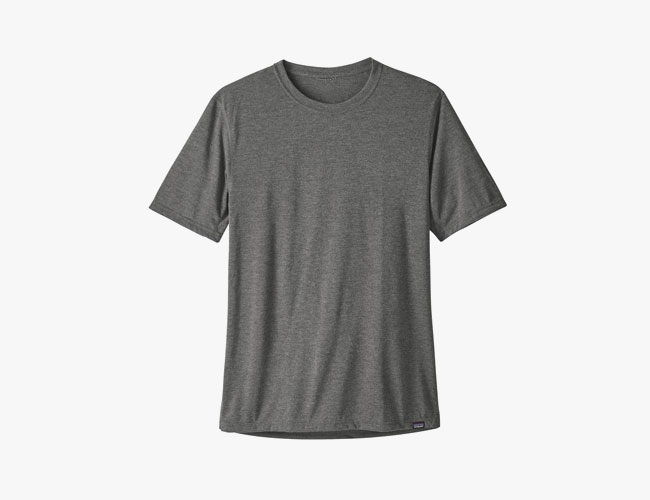Running is an inherently uncomfortable activity — labored breathing, tired muscles and, when the weather heats up like it’s starting to now, you’re stuck dealing with sweat-ridden clothes and probably a ton of smelly workout laundry. However, if you’re like most runners, you probably spend more time reading up on running shoes than running shirts. Makes sense; besides color, shirts all look pretty similar online. Even my own research on features began to blend together. Everything is lightweight, keeps you cool and wicks moisture — the typical marketing jargon for technical clothing. However, I found that seemingly identical-looking shirts varied quite a bit when I put each through the trial of miles, even if their online descriptions read alike.
How We Tested Running Shirts
Sifting through the multitude of options, I browsed countless online reviews to narrow down what the “Internet” claimed were the best running shirts. My search resulted in more than 30 short-sleeve and sleeveless shirts, which I tested over a two-month period. My testing ground was the sunny beach paths and mountainous trails of Santa Barbara, California. As a full-time running coach, I spent every day in one of the shirts. My goal was to wear them as much as possible — not only running but in the gym, hiking and rock climbing — to narrow the field down to the top 12. Here’s what stood out to me, followed by some handy tips for shopping, combating chafing and keeping your shirts in as good of shape as you are.
Black Diamond Rhythm Tee
I can’t get enough of this shirt. At nearly a full ounce lighter than any other running shirt tested, the Rhythm Tee felt weightless and outperformed others in wicking and drying ability. Featuring NuYarn Merino Wool, an innovative knitting process that wraps merino wool around a nylon core, this shirt results in a high output technical tee that’s stretchier, faster drying and stronger than 100 percent wool shirts.
Material: 57% Nylon, 43% NuYarn Merino Wool
UPF Sun Protection: Yes (not rated)
Odor Protection: Yes
Weight: 2.4oz
The North Face Better Than Naked Short Sleeve
Making our list for the second year in a row, this one’s our go-to shirt on hot and humid days when it’s a coin toss whether to go shirtless or not. Lightweight and airy, the Better Than Naked boasts a body-mapped jacquard mesh design to move moisture off your body and into the shirt. An extra stretchy vertical mesh down the back adds extra ventilation when wearing a hydration pack, making this top ideal for ultra running. Also available in sleeveless.
Material: 100% Polyester
UPF Sun Protection: Less than 15
Odor Protection: No
Weight: 3.2oz
Old Navy Ultra-Soft Breathe ON Go-Dry Built-In Flex Tee
Despite a marginal difference in wicking ability compared to its more expensive counterparts, this Old Navy performance tee earned its place as a top technical tee due to its affordable price-point. The soft jersey-knit fabric with built-in stretch allows body heat to escape while absorbing moisture. Thin and slightly transparent material is good for breathability but, as expected for a budget shirt, sacrifices durability.
Material: 95% polyester, 5% spandex
UPF Sun Protection: Unknown
Odor Protection: No
Weight: 4.7oz
Saucony Freedom Short Sleeve
This soft, jersey-knit tee felt like cotton against the skin but performed like a technical running top. Superb wicking powers and a somewhat relaxed, stretchy fit through the body felt very mobile and freeing during the run. That said, as expected for a jersey knit, the Freedom Shirt was one of the thicker and heavier tees tested.
Material: 83% Polyester, 11% Tencel, 5% Spandex
UPF Sun Protection: Less than 40
Odor Protection: Yes
Weight: 4.9oz
Janji Orbital Singlet
Better be prepared to run fast in Janji’s eye-catching Orbital Singlet. This race-ready tank is paper-thin with an aggressive cut through the shoulders and back, allowing unrestricted arm swing. Fun, colorful patterns stand out among the sea of solid-colored running shirts. Unisex sizing with an ultra-slim, athletic fit made a size small feel custom-tailored to my trim 5’8″, 140-pound frame. If you prefer a looser fitting tank, I suggest sizing up.
Material: 88% recycled polyester, 12% elastane
UPF Sun Protection: 15 Rating
Odor Protection: No
Weight: 2oz
Arc’teryx Motus Crew Neck Shirt Short Sleeve
Designed specifically for trail running, beautifully constructed and durable as hell, this lightweight crew managed moisture seamlessly, wicking sweat away from the skin and drying quickly. In typical Arc’teryx fashion, no design detail has been taken lightly. It’s anatomically cut, noticeable by the contrast stitching, and gusseted arms plus a slim fit throughout offer uninhibited movement. As a bonus, the Motus Crew makes a fantastic baselayer for winter running.
Material: 100% Polyester
UPF Sun Protection: 25 Rating
Odor Protection: Yes
Weight: 3.7oz
Patagonia Men’s Capilene Cool Trail Shirt
Soft enough to sleep in, this jersey-knit tee was one of the softest and most comfortable running tops tested. With the texture and feel of cotton, this Fair Trade Certified shirt blends the lines between a performance tee and everyday tee. Classic style and Polygiene permanent odor treatment make it a great option for runs that end in a social gathering. If you dislike the feel of synthetic fabric, the Capilene Cool Trail Shirt should be at the top of your list.
Material: 100% Polyester
UPF Sun Protection: Yes (not rated)
Odor Protection: Yes
Weight: 4.6oz
Baleaf Men’s Quick Dry Short Sleeve
If price is your number one priority, superseding durability and top-level performance, look no further than this Amazon top seller. Smooth-faced with more stretch than most, this polyester/spandex blend tee felt silk-like, gliding over the body with every move. And as it’s offered in 14 colors, odds are you’ll easily be able to match your favorite shorts.
Material: 92% Polyester / 8% Spandex
UPF Sun Protection: Unknown
Odor Protection: No
Weight: 4.9oz
Adidas Terrex Agravic Parley Tee
When it comes to price versus performance, the adidas Terrex Agravic Parley is hard to top. At a relatively modest $35 price point, this environmentally friendly shirt is made with yarn from recycled waste reclaimed on coastal beaches before it ends up in the ocean. Paper thin and weighing in as one of the lightest shirts tested, this shirt felt refreshingly airy on the run. Heads up on sizing — despite being advertised as a regular fit, I found it to fit more on the slim side compared to others.
Material: 80% Recycled Polyester / 20% Polyester
UPF Sun Protection: No
Odor Protection: No
Weight: 3.2oz
Under Armour Rush Run Short Sleeve
Launched just last month, Under Armour’s Rush line pushes the boundaries of high-tech athletic wear. Like other items in the line, this shirt’s made with mineral-infused fabric designed to absorb and recycle your body’s energy, promoting better circulation and increased tissue oxidation levels for faster recovery. Did it work? May simply be a placebo effect, but I will say the material did feel better against my skin than any other shirt. Body-mapped mesh panels provide extra ventilation in high-heat areas, too.
Material: Body: 82% Polyester18% Elastane; Mesh Panels: 90% Polyester/10% Elastane
UPF Sun Protection: Yes (not rated)
Odor Protection: Yes
Weight: 4.3oz
Brooks Stealth Short Sleeve
Lightweight and breathable, the Brooks Stealth remained comfortable, even during the longest outings. Its silky smooth-faced front and back with clean seams allowed unrestricted movement. Vented mesh panels extend along the sides, helped dump underarm heat. A generous 90-day return policy, even on used gear, helps make this purchase a no-risk no-brainer. Also available in sleeveless.
Material: Body: 100% Polyester
UPF Sun Protection: Yes (not rated)
Odor Protection: Yes
Weight: 3.5oz
Rhone Swift Tank
From one of our favorite boutique brands, Rhone, this sleek tank not only kept me cool mid-run, it doubles as a great gym tank. Visible horizontal mesh lines maximize airflow through the fabric, providing a cooling effect.
Material: 88% Polyester/12% Elastane
UPF Sun Protection: Yes (not rated)
Odor Protection: Yes
Weight: 3.2oz
What to Know Before You Buy
Fabric technology has come a long way, helping combat sweat, chafing, odor and in some cases possibly helping you recover faster. Here’s what you should look for when buying a running shirt.
1. Wicking Ability, Drying Time and Fit
Perhaps the two most important qualities of a good running shirt are wicking ability and drying time. Wicking is the process of transferring moisture or sweat away from your body through tiny spaces within the weave of the fabric and then dispersing it to the outer layer to evaporate. Evaporation rate, or drying time, will vary depending on the dew point, but generally, a quality moisture-wicking shirt should dry within a couple of minutes after you stop running.
Brands categorize fit based on body type, using terms such as fitted, slim/trim, athletic or regular. The actual fit will vary quite a bit from brand to brand, and based on your body type, but in most cases fitted shirts are close to skintight and regular shirts are fairly loose, with slim and athletic falling somewhere in the middle. A proper fitting running shirt is somewhat dependent on personal preference. One thing to keep in mind: Shirts that are too tight will be more likely to cause rubbing, whereas ones that are too loose will be less likely to wick sweat and more likely to chafe.
2. Look for Polyester or Wool Blends
The two most common moisture-wicking fabrics are polyester, a synthetic fabric, and wool, a natural fabric. On paper, polyester holds a slight advantage over wool for running, mainly because it is less expensive and offers better durability. Wool, which has somewhat of a cult following in the hiking world for its exceptional odor control, is my go-to while traveling or when washing between each use isn’t possible. A third material, cotton, is one of the worst moisture-wicking fabrics. Instead of dispersing moisture over a large area to evaporate, cotton absorbs and retains moisture, leaving the shirt feeling heavy and damp. Think back to field day in school; when your cotton tee got soaked during the water balloon toss, you likely weren’t dry for the remainder of the day.
3. Bonus: Sun Protection and Odor Control
Additional features such as UPF sun protection and odor control are common in running-specific shirts. UPF is a rating system used in clothing to measure how much harmful UVA and UVB light passes through the fabric. The higher the rating, the better the protection the shirt offers. This becomes an important consideration for summer running, especially during long runs and high-altitude runs when sun exposure is high.
Over time, bacteria can form within the fabric, causing a lasting odor that laundry detergent can’t remove. Odor-protected fabric works to prevent the buildup of these smelly bacteria. To achieve odor protection, companies will treat the fabric with an anti-odor finish such as Polygiene. Wool, on the other hand, is naturally resistant to the buildup of odor-causing bacteria.
Beware of Chafing
Chafing is the bane of many runners during the dog days of summer. The repetitive friction between your skin and the fabric causes the condition, and sweat- or rain-dampened skin is more prone to it. The best remedy is to try a shirt with a different fabric make-up and fit. If you’re running in a 100 percent polyester, regular-fit shirt, try switching it up to a wool blend with a more athletic cut.
Wash with Care
Moisture-wicking shirts require a little more care than your cotton-based clothes if you want to keep them in your rotation year after year. Excess detergent and fabric softeners can trap the odor-causing bacteria, making it increasingly difficult to remove the stench over time. What you’ll want to do is turn your clothes inside-out and reduce the amount of detergent used, or try sports-specific cleaning products such as Win Sports Detergent. Avoid high heat settings and any form of fabric softener, too.















